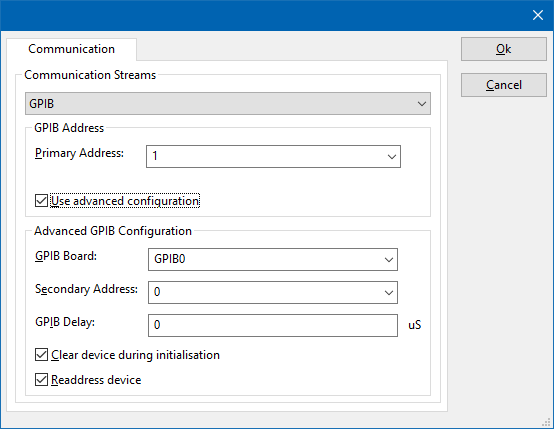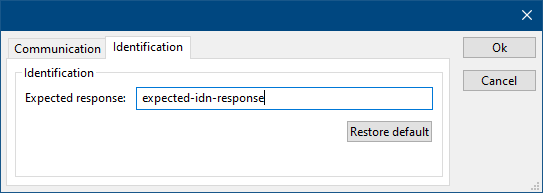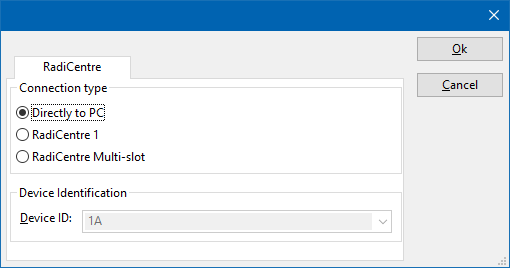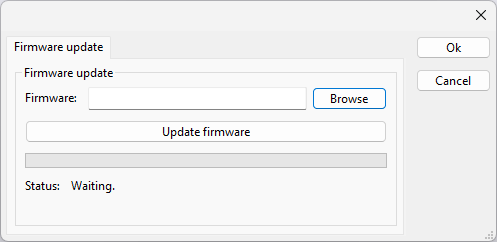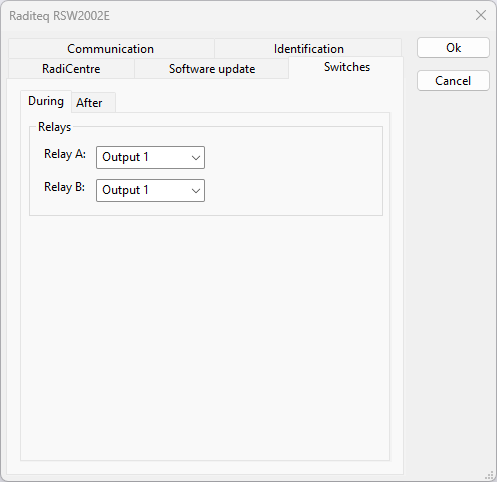DARE!! Development RadiCentre (2 Port + External)
The DARE!! Development RadiCentre (2 Port + External) device driver is a Switch Matrix which is supported by RadiMation®.
Configuration[edit]
The following tabs are available in the advanced configuration of the DARE!! Development RadiCentre (2 Port + External):
On the Communication tab, the desired communication method can be selected and configured. Depending on the selected method, additional relevant settings are shown and can be configured.
| Selects the medium or method that should be used to communicate with the device. Depending on the capabilities of the device this can be one or more of:
Depending on the selected communication stream, additional configuration parameters can be configured. See the Communication Settings in Chapter 15, on how to configure each of these communication streams. |
On the Identification tab, the expected *IDN? response of the test and measurement device can be configured. It is used to determine if the correct test and measurement device is connected.
| The expected *IDN? response of a device. It can be changed in the case the commands are the same for another device for which no RadiMation® driver is available yet. |
| Restores the original Exepected response. |
There are several methods in which the DARE!! Development RadiCentre (2 Port + External) can be connected to the PC. The DARE!! Development RadiCentre (2 Port + External) can for example be connected directly to the PC, or through a plugincard in a RadiCentre 1 or a multi-slot RadiCentre. More information on how to use the RadiCentre is present in the product manual of the RadiCentre. The settings on the RadiCentre tab can be used to specify how the DARE!! Development RadiCentre (2 Port + External) is connected.
When the DARE!! Development RadiCentre (2 Port + External) is connected to a multi-slot RadiCentre, also the slot number in which the plugincard is fitted, should be specified.
| Specifies that the DARE!! Development RadiCentre (2 Port + External) is connected directly to the PC, without the use of a RadiCentre. |
| Specifies that the DARE!! Development RadiCentre (2 Port + External) is connected to a plugincard that is fitted in a RadiCentre 1. |
| Specifies that the DARE!! Development RadiCentre (2 Port + External) is connected to a plugincard that is fitted in a multi-slot RadiCentre that also can be manually controlled using the display on the front of the RadiCentre. The slot number in which the plugin card is mounted can also be selected. |
| Specifies that the DARE!! Development RadiCentre (2 Port + External) is connected to a plugincard that is fitted in a multi-slot RadiCentre Ultra. This RadiCentre Ultra has no display, and can only be used when remote controlled. |
The settings on this RadiCentre tab, only specifies if and which RadiCentre is used. The communication settings on the Communication tab specify the connection settings to communication with the measurement device.
The configuration on the Communication tab should be configured depending on the outgoing connection from the PC. Thus if Directly to PC is selected, the communication settings should be configured as what is actually used between the PC and the DARE!! Development RadiCentre (2 Port + External) itself. If RadiCentre 1, RadiCentre multi-slot or RadiCentre multi-slot Ultra is selected, the communication settings should be configured as what is actually used between the PC and the RadiCentre. In the configuration where a RadiPower is connected with USB to a multi-slot RadiCentre, which is connected by GPIB to the PC, the communication settings of the RadiPower device driver should thus be GPIB.
If the DARE!! Development RadiCentre (2 Port + External) is for example connected to slot 3 of a multi-slot RadiCentre which has IP address 192.168.178.95 and is connected by LAN to the PC, the following settings should be configured in the device driver of the DARE!! Development RadiCentre (2 Port + External):
- RadiCentre tab
- Connection type: RadiCentre multi-slot, using as slot number: 3
- Communication tab
- Communication Stream: VISA
- LAN: 192.168.178.95
The Firmware update tab can be used to update the firmware of the DARE!! Development RadiCentre (2 Port + External).
| Specifies the filename of the firmware update file that should be used to update the firmware of the measurement device. |
| Allows to select the firmware update file. |
| Starts the actual firmware update. First some checks are performed, and if those checks are successful, the actual firmware update is performed. |
| Shows a message during the firmware update, indicating the performed action and the actual status. |
| Warning: | The firmware update can take a few minutes. During the actual firmware update the window is disabled, and cannot be closed. It is possible that Microsoft Windows shows messages that the RadiMation® software is not responding. Ignore those messages and do not kill, abort or end the software. Also do not disconnect the connection between the DARE!! Development RadiCentre (2 Port + External) and the PC, while the firmware update is being performed. |
After the firmware update is completed, a messagebox will be shown that the firmware update has been completed successfully. In the case that an error has occurred, this will also be shown. In case that an error has been detected, it is strongly suggested to directly use the RadiMation® Error Report function to report the error to Raditeq.
The Switches tab allows to configure the actual state of the relay on the switch card.
|
There are two switch configurations. These two configurations are during and after the test. The settings on the During tab are send to the switch matrix just before the test is started. The settings on the After tab are send to the switch matrix after the test has ended.
|
